![]()
![]()
![]()
Use LEFT and RIGHT arrow keys to navigate between flashcards;
Use UP and DOWN arrow keys to flip the card;
H to show hint;
A reads text to speech;
81 Cards in this Set
- Front
- Back
|
What is (joint) mobilization per Kisner and Colby? ***
|
passive, skilled manual therapy techniques, applied to joints and related soft tissues at varying speeds and amplitudes using physiologic or accessory motions
|
|
|
Name another term for "mobilization." ***
|
manipulation (the terms are synonymous)
|
|
|
What is the definition of joint mobilization/manipulation per the APTA Guide to PT Practice? ***
|
the skilled passive movement of a joint and/or related soft tissues at varying speeds and amplitudes up to and including a small amplitude, high velocity thrust
|
|
|
What is a thrust? ***
|
high-velocity, short amplitude motion performed at end of pathologic limit to alter position or snap adhesions
|
|
|
What are physiologic movements? ***
|
- voluntary motions that occur within the joint ROM
- occur in cardinal planes - a.k.a. osteokinematic, or swing, motions - e.g., flexion, extension |
|
|
What are accessory movements? ***
|
- involuntary movements
- necessary for normal ROM |
|
|
Name two accessory movements. ***
|
- component motions
- joint play |
|
|
What are component motions? ***
|
- accessory motions that occur with voluntary movement
(e.g., shoulder flexion with shoulder girdle rotation; scapula & AC / SC movement; tibia & femur with the "screw home" motion) - these motions cannot occur independently, but must occur for normal joint movement |
|
|
What is joint play? ***
|
- occurs within joint
- necessary for full ROM - only passive; usually a combination |
|
|
What is another name for joint play? ***
|
arthrokinematics
|
|
|
List the arthrokinematic/joint play motions. ***
|
- roll
- spin - slide/glide - distraction - compression |
|
|
What is distraction (or traction)? ***
|
separation of joint surfaces
|
|
|
What is compression? ***
|
decrease in joint space between bony partners
|
|
|
What is a roll? ***
|
new points on one surface meet new points on opposing surface
|
|
|
What is a spin? ***
|
rotation of moving joint surface on fixed adjacent surface
|
|
|
What is a slide/glide? ***
|
same point on one surface comes into contact with new points on opposing surface
|
|
|
What two arthrokinematic/joint play motions are used with mobilization/manipulation? ***
|
- distraction
- slide/glide |
|
|
What is the close-packed position? ***
|
- joint surfaces are maximally congruent
- ligaments are taut - joint has most stability, least mobility, but is susceptible to injury |
|
|
What is the loose-pack (open-packed) position? ***
|
- articulating joint surfaces are maximally separated
- ligaments are relaxed - joint has the most give, is least stable, but can absorb forces |
|
|
What determines the direction of movement for joint mobilization/manipulation? ***
|
the treatment plane
|
|
|
What is the treatment plane? ***
|
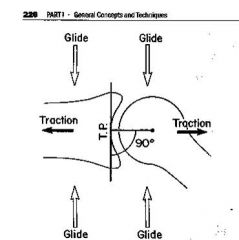
- plane perpendicular to a line running from axis of rotation to middle of concave articular surface
- plane is in concave partner |
|
|
How are distraction and slide/glide applied, relative to the treatment plane? ***
|
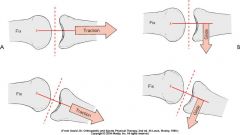
- distraction/traction techniques applied perpendicular to treatment plane
- sliding/gliding techniques applied parallel to treatment plane |
|
|
What is the concave-convex rule with respect to joint mobilization/manipulation? ***
|
- if surface of moving bone is convex, sliding is in opposite direction of swing
- if surface of moving bone is concave, sliding is in same direction of swing |
|
|
Describe the slide/glide motion of a convex moving bone. ***
|
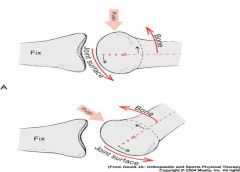
if surface of moving bone is convex, sliding is in opposite direction of swing
|
|
|
Describe the slide/glide motion of a concave moving bone. ***
|
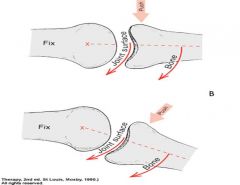
if surface of moving bone is concave, sliding is in the same direction of swing
|
|
|
Traction techniques are applied _______ to the treatment plane. ***
|
perpendicular
|
|
|
Gliding techniques are applied ________ to the treatment plane. ***
|
parallel
|
|
|
Inferior glide of the glenohumeral joint is used to increase a(n) ________ restriction. ***
|
abduction
|
|
|
Anterior glide of the glenohumeral joint is used to increase a(n) ________ restriction. ***
|
extension and/or external rotation
|
|
|
Posterior glide of the glenohumeral joint is used to increase a(n) ________ restriction. ***
|
flexion and/or internal rotation
|
|
|
Volar glide of the radiocarpal joint is used to increase a(n) _______ restriction. ***
|
extension
|
|
|
Dorsal glide of the radiocarpal joint is used to increase a(n) _______ restriction. ***
|
flexion
|
|
|
Radial glide of the radiocarpal joint is used to increase a(n) _______ restriction. ***
|
ulnar deviation
|
|
|
Radial glide of the radiocarpal joint is used to increase a(n) _______ restriction. ***
|
radial deviation
(Her lecture notes say radial glide to increase radial deviation restriction--should probably be ulnar though. Need to verify this!!) |
|
|
At the MCP and IP joints, volar glide is used to increase a(n) _____ restriction. ***
|
flexion
|
|
|
At the MCP and IP joints, dorsal glide is used to increase a(n) _____ restriction. ***
|
extension
|
|
|
At the tibiofemoral joint, posterior glide is used to increase a(n) ________ restriction. ***
|
flexion
|
|
|
At the tibiofemoral joint, anterior glide is used to increase a(n) ________ restriction. ***
|
extension
|
|
|
How many grades of Kaltenborn/sustained translatory joint play distraction are there? ***
|
three
|
|
|
What are the three grades of Kaltenborn/sustained translatory joint play distraction? ***
|
- grade I - loosen
- grade II - tighten - grade III - stretch |
|
|
Grade I Kaltenborn/sustained translatory joint play distraction operates within... ***
|

the range of available joint play, but not to the point of tissue resistance
|
|
|
Grade II Kaltenborn/sustained translatory joint play distraction operates within... ***
|
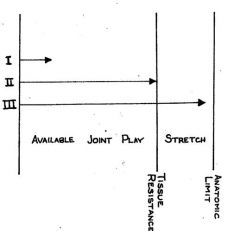
the range of available joint play, up to the point of tissue resistance, but not into a stretch
|
|
|
Grade III Kaltenborn/sustained translatory joint play distraction operates within... ***
|
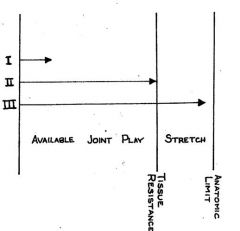
the range of tissue stretch, up to the anatomical limit
|
|
|
Describe a Grade I Kaltenborn/sustained translatory joint play distraction. ***
|
- loosening of the joint
- a small-amplitude distraction |
|
|
Describe a Grade II Kaltenborn/sustained translatory joint play distraction. ***
|
- tightening of the tissues
- enough distraction or glide to "take up the slack" |
|
|
Describe a Grade III Kaltenborn/sustained translatory joint play distraction. ***
|
- stretch
- enough distraction/glide to stretch the capsule and surrounding ST |
|
|
For what is a Grade I Kaltenborn/sustained translatory joint play distraction used? ***
|
- pain relief
- with ALL glides |
|
|
For what is a Grade II Kaltenborn/sustained translatory joint play distraction used? ***
|
- pain relief
- to maintain available joint play |
|
|
For what is a Grade III Kaltenborn/sustained translatory joint play distraction used? ***
|
to stretch joint structures
|
|
|
Describe a Grade I Maitland oscillation. ***
|
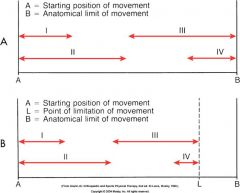
small-amplitude rhythmic oscillations performed at beginning or range
|
|
|
Describe a Grade II Maitland oscillation. ***
|
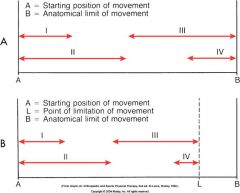
large-amplitude rhythmic oscillation, not reaching limit
|
|
|
Describe a Grade III Maitland oscillation. ***
|
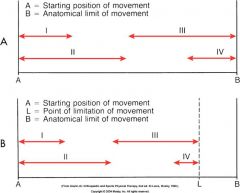
large-amplitude rhythmic oscillations performed up to limit of available motion, and stressed into tissue resistance
|
|
|
Describe a Grade IV Maitland oscillation. ***
|
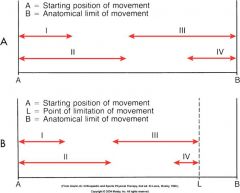
small-amplitude rhythmic oscillations performed at limit of available motion, and stressed into tissue resistance
|
|
|
Describe a Grade V Maitland oscillation. ***
|
- small-amplitude,high velocity thrust performed to snap adhesions at limit of available motion
- NOT USED BY PTAs |
|
|
For what are Grades I and II Maitland oscillations used? ***
|
- to treat pain
- to help move synovial fluid |
|
|
For what are Grades III and IV Maitland oscillations used? ***
|
for stretching
|
|
|
What are some of the specifics she listed for administration of mobilization/manipulation? ***
|
- traction is perpendicular; slide is parallel
- patient must be comfortable and in agreement - always stabilize with one hand, mobilize with other - only one joint at a time to be mobilized - joint placed in resting or loose-packed position - do not move into pain - use Grade I distraction first - observe and assess as you treat |
|
|
What are some indications for joint mobilization/manipulation? ***
|
- pain
- joint hypomobility - muscle spasm - muscle guarding |
|
|
Name some contraindications/precautions for joint mobilization/manipulation. ***
|
- hypermobility
- excessive pain - effusion - inflammation - unhealed fracture - osteoporosis - pregnancy - elderly - malignancy - OA - RA - total joint replacement (precaution) |
|
|
What is Shankman's definition of mobilization? ***
|
an attempt to restore joint motion or mobility, or decrease pain associated with joint structures using manual, passive accessory joint movement
|
|
|
Open- and closed-pack positions for:
facet joints of spine |
- midway between flexion and extension
- extension |
|
|
Open- and closed-pack positions for:
TMJ |
- mouth slightly open
- clenched teeth |
|
|
Open- and closed-pack positions for:
glenohumeral joint |
- 55 degrees abduction, 30 degrees horizontal adduction
- abduction and external rotation |
|
|
Open- and closed-pack positions for:
acromioclavicular joint |
- arm resting by side in normal physiologic position
- arm abducted to 90 degrees |
|
|
Open- and closed-pack positions for:
sternoclavicular joint |
- arm resting by side in normal physiologic position
- maximum shoulder elevation |
|
|
Open- and closed-pack positions for:
ulnohumeral joint |
- 70 degrees flexion, 10 degrees supination
- extension |
|
|
Open- and closed-pack positions for:
radiohumeral joint |
- full extension, full supination
- elbow flexed to 90 degrees, forearm supinated 5 degrees |
|
|
Open- and closed-pack positions for:
proximal radioulnar joint |
- 70 degrees flexion, 35 degrees supination
- 5 degrees supination |
|
|
Open- and closed-pack positions for:
distal radioulnar joint |
- 10 degrees supination
- 5 degrees supination |
|
|
Open- and closed-pack positions for:
radiocarpal (wrist) joint |
- neutral with slight ulnar deviation
- extension with radial deviation |
|
|
Open- and closed-pack positions for:
carpometacarpal joint |
- midway between abduction-adduction and flexion-extension
- extension with radial deviation |
|
|
Open- and closed-pack positions for:
all metacarpophalangeal joints |
- slight flexion
- full flexion (fingers) - full opposition (thumb) |
|
|
Open- and closed-pack positions for:
interphalangeal joints |
- slight flexion
- full extension |
|
|
Open- and closed-pack positions for:
hip joint |
- 30 degrees flexion, 30 degrees abduction, slight external rotation
- full extension, internal rotation |
|
|
Open- and closed-pack positions for:
knee joint |
- 25 degrees flexion
- full extension, external rotation of tibia |
|
|
Open- and closed-pack positions for:
talocrural joint (ankle) |
- 10 degrees plantar flexion, midway between maximum inversion and maximum eversion
- maximum dorsiflexion |
|
|
Open- and closed-pack positions for:
subtalar joint |
- midway between extremes of range of motion
- supination |
|
|
Open- and closed-pack positions for:
midtarsal joint |
- midway between extremes of range of motion
- supination |
|
|
Open- and closed-pack positions for:
tarsometatarsal joint |
- midway between extremes of range of motion
- supination |
|
|
Open- and closed-pack positions for:
metatarsophalangeal joint |
- neutral
- full extension |
|
|
Open- and closed-pack positions for:
interphalangeal joints |
- slight flexion
- full extension |

